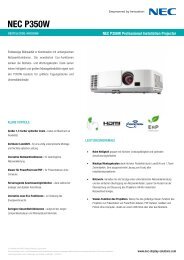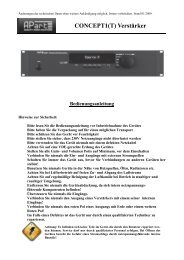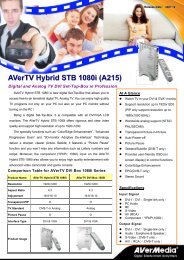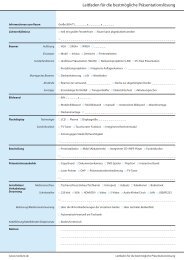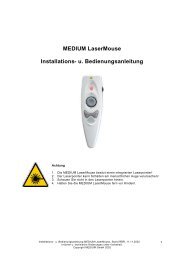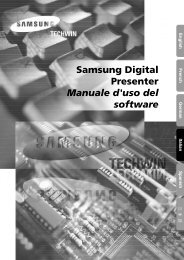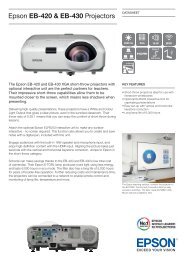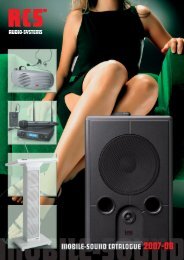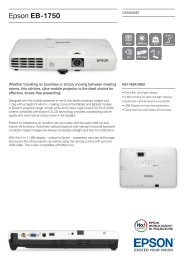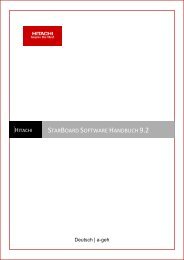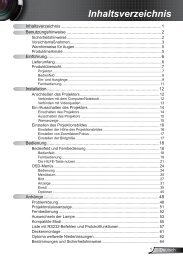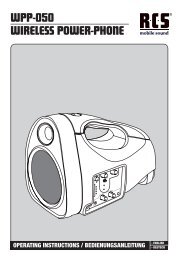The Conference Company - Medium
The Conference Company - Medium
The Conference Company - Medium
Create successful ePaper yourself
Turn your PDF publications into a flip-book with our unique Google optimized e-Paper software.
How to find the right screen for any presentation<br />
<strong>The</strong> main considerations for choosing the<br />
right screen are:<br />
● the screen type<br />
● the screen size<br />
● the aspect ratio (width/height)<br />
● the screen surface<br />
● the projector<br />
<strong>The</strong> Screen Type<br />
Mobile or fixed? <strong>The</strong> broad MEDIUM product<br />
range offers the correct screen solution for<br />
any presentation requirement. Thanks to<br />
their perfectly flat surfaces all screens<br />
provide an excellent image performance.<br />
<strong>The</strong> Screen Size<br />
<strong>The</strong> general rule of thumb to determine<br />
screen size is:<br />
● the minimum distance from screen to the<br />
front row of seats should be 1.5 times the<br />
width of the screen<br />
● the maximum distance for the audience<br />
should not exceed 6 times the screen<br />
width<br />
● the lower border of the screen should be<br />
90 - 120 cm above the floor (for seated<br />
rows!)<br />
<strong>The</strong> Aspect Ratio<br />
Each projection method has its particular<br />
ratio of width to height. <strong>The</strong> most common<br />
ratios are:<br />
Projection size W : H<br />
Digital video projection 4 : 3<br />
Widescreen projection (HDTV) 16 : 9<br />
Overhead projection 1 : 1<br />
Slide projection 3 : 2<br />
Moreover, many MEDIUM screen types can<br />
be adjusted to specific project or customer<br />
requirements.<br />
<strong>The</strong> appropriate screen for any presentation<br />
<strong>The</strong> Screen Surface<br />
<strong>The</strong> reflection quality of your screen is<br />
defined by the brightness gain:<br />
● <strong>The</strong> higher the brightness gain, the more<br />
restricted the viewing angle<br />
Different coatings of the screen surface<br />
involve different reflective properties.<br />
MEDIUM offer screens with two different<br />
reflection properties.<br />
Type D (d=diffuse) Screen Surfaces:<br />
● scatter the light evenly in all directions<br />
(horizontally and vertically)<br />
● have a matt white surface<br />
● provide good viewing angle conditions up<br />
to 45° r/l of the projection axis and<br />
acceptable conditions even up to 55-60°<br />
● correspond to a measured brightness gain<br />
factor of 1.0 - 1.2 (DIN 19045)<br />
Type S (s=specular) Screen Surfaces<br />
● reflect the light along the projection axis<br />
twice as intensely as Type D screens<br />
● have a pearl pigment coating<br />
● provide excellent, very bright viewing<br />
conditions up to 30-40° r/l of the<br />
projection axis<br />
● correspond to a measured brightness gain<br />
factor from 1.8 - 2.4 (DIN 19045)<br />
Roll down Tripod Fold Mobile Table top<br />
Projection type Type D Type S Screen Screen Screen Screen Screen<br />
Stationary use ● ● ● ● ● – –<br />
Mobile use<br />
Brighter room without<br />
dimming / less<br />
● ● – ● ● ● ●<br />
powerful projector – ● ● ● – ● ●<br />
Audience seated in centre<br />
Darkened room/<br />
– ● ● ● – ● ●<br />
powerful projector ● – ● ● ● ● ●<br />
Audience seated spread out ● – ● ● ● – ●<br />
● recommended – not optimally suited<br />
0% 10% 100%<br />
Listen View<br />
optimal information processing<br />
<strong>The</strong> Screen Size<br />
e Screen width<br />
r Recommended height of lower screen edge<br />
t Minimum distance: 1.5x the projection width<br />
u Maximum distance: 6x the projection width<br />
i Viewing angle of 45-50°<br />
o Viewing angle of 30-40°<br />
<strong>The</strong> Projector<br />
Type D screens are mainly suited for medium<br />
to high brightness projectors (2,000 ANSI<br />
lumens and above) in rooms that can be<br />
partially darkened. <strong>The</strong> projection surface<br />
should not exceed approx. 5 m≈.<br />
Type S screens achieve better results when<br />
less bright projectors are used, in<br />
environments with a high degree of ambient<br />
light or when large screen surfaces are<br />
required.<br />
Reflection properties Type D/S<br />
Brightness gain factor<br />
2<br />
1.5<br />
1<br />
0.5<br />
50° 40° 30° 20° 10° 0° 10° 20° 30° 40° 50°<br />
Viewing angle<br />
Projector<br />
● type S screen<br />
● type D screen<br />
● regular = standard white<br />
Screen<br />
● All MEDIUM screens are CE certified and<br />
conform to DIN 19045,1-5 / DIN 4102 B2<br />
technical standards.<br />
● Please contact your local MEDIUM partner to<br />
discuss your projection requirements and<br />
solutions.<br />
Screens<br />
73



